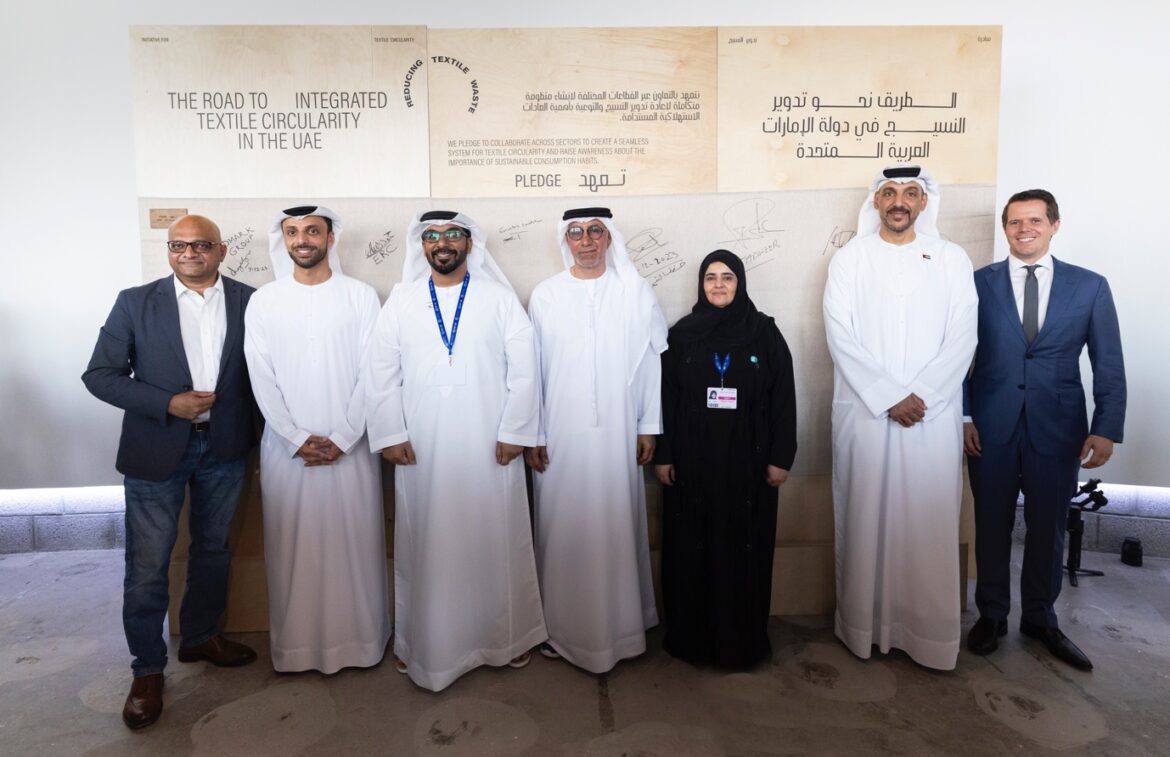The fashion industry contributes to around ten per cent of emissions globally, guzzles trillions of litres of water yearly and pollutes our oceans at a massive scale.
On top of this, just 1 per cent of clothing is recycled, meaning that the vast majority is diverted to landfill.
There, materials can take over two hundred years to biodegrade, all the while having a devastating impact on both the environment and our health.
For too long, the fashion industry has evaded its environmental responsibility and is one of the major culprits of greenwashing.
But the take-make-dispose model it employs and its failure to act is destroying the planet; new systems of operation are needed now, and this can not be delayed any further.
This week at COP28, regional and international figures from across the industry were represented on a panel titled: “The Road to Integrated Textile Circularity,” where panellists discussed where the industry is on its circularity journey, and the launch of the ‘Integrated Textile Circularity Initiative.’
The initiative, the first of its kind in the region, aims to catalyse collective action among public-private partners throughout the entire value chain, and raise consumer awareness.
Initiative to emphasise “waste as a resource”
Underlined at the event was the necessity to throw out the linear approach to textiles and fashion.
Eng. Ali Al Dhaheri, Managing Director and Chief Executive Officer of Tadweer, Abu Dhabi Waste Management Company, opened with remarks highlighting the current state of affairs in the UAE.
Each year in the UAE, Al Dhaheri explained, around 500 million pieces of textiles are consumed across households and commercial entities, resulting in 210,000 tonnes of discarded textiles.
“Regrettably, less than 10 per cent of this is currently formally collected for recycling,” he said, adding that this results in significant environmental damage.
Al Dhaheri noted that Tadweer envisions a future where sustainability is “not an option, but a way of life” and “waste is a resource.”
So, how do we get to this point?
Al Dhaheri shared that the newly launched initiative, comprising four pillars, aims to set out the path for action.
The first pillar of the initiative is focused on community awareness and development programmes, while the second targets collection programmes on recycling, aiming to establish local recycling facilities, to help foster a self-sufficient ecosystem within the UAE.
The third pillar, he shared, is focused on enabling ecosystem participation and here, collaboration was highlighted as key.
The fourth and final pillar involves supporting and establishing a baseline for ambitions and shaping the national policy landscape.
“This involves conducting thorough studies to understand the current stage of textile waste, and developing processes and capabilities that align with our national ambition on textile circularity.”
Mobilising action & employing holistic approaches
Panelists welcomed the initiative, which they said is an important first step toward change.
Indeed, Al Dhaheri told ESG Mena that the initiative seeks to strengthen awareness around textile recycling among government, the private sector, communities and individuals: “I think that is, for me, the most important thing,” adding: “Beyond that, it will open up opportunities for SMEs to come up with [innovative] technologies and processes that can be addressed in developing and building an efficient ecosystem around textile recycling.”
Likewise, Mohamed Althaf, Director of Lulu Group International, said the initiative will have a “material effect in terms of the impact.”
However, when it comes to realising a circular cycle within the industry, there are significant barriers. One consideration is that synthetic fibre blends currently comprise around 60 per cent of all materials worldwide, meaning that not only are they difficult to process, when they’re recycled, there’s a serious microplastics issue, too.
Moreover, their continued domination within textiles keeps the industry reliant on petrochemical industries, meaning it’s imperative for the industry to shift to and scale up the use of natural fibres.
André Willenbrecht, Managing Director of SOEX said that the company is tackling chemical recycling with “major chemical companies.”
“The chemical recycling is taking place already. We are able to break polyamide 6 and 66 down of the garment, and return it.”
“We scan for material which cannot be re-worn or reused with a near-infrared scanner, and this tells you what material is. Is it cotton silk? Or is it polyamide 6 or 66? And then you can bring it back to the recycling,” he said.
Willenbrecht said the company’s own house solution is capable of processing hundreds of tonnes per day, Willenbrecht explained.
Policy meets private-sector action
Also highlighted at the event was the role of policy in reshaping approaches in textiles. Othaibah Saeed AlQaydi, Acting Assistant Undersecretary of Sustainable Communities Sector, for example, said on the path to circularity, the effective implementation and enforcement of policy is “critical.”
Here, Rajesh Garg, Chief Finance Officer of Landmark Group, said that companies need supportive policies to ensure that they don’t bear all the costs.
“Until the customer is paying a premium, it’s all cost for me,” he said.
“I’m very glad we have the policymakers here, because we need a clear, unfettered way to collect our products,” Garg said. Further, he noted that although charities play a role, they can only collect between 5 and 10 per cent, and to scale, there needs to be a “systematic solution.”
Meanwhile, when asked about scaling infrastructure to accommodate the ramping up of new approaches, Al Dhaheri said: “I think we can leverage our experience from other streams and our experience in developing some of these infrastructures to accelerate and leverage technical expertise, and operational resources to fast track the infrastructure required for textile recycling.”
Speaking on circularity within the industry, Youssef Chehade, Co-Founder, Ecyclex, one of the supporters of the initiative, said: “ReLoop by Ecyclex, being a digital circular economy recycling app connected to the recycling facilities of Ecyclex, will help in increasing the accessibility to textile recycling by providing convenient take-back programs, and doorstep collection of textiles from homes, retailers and companies.”
“With such convenience, we help address one of the key challenges, which is changing the behaviour of individuals,” he added.
Tidal wave of fast fashion a dangerous trend
Fast fashion is on an upward trajectory, dominated by brands such as Shein, ASOS, Zara, and FashionNova, and according to panellists, its world domination is being accelerated by social media apps like TikTok.
Compounding fashion’s already massive waste problem, fast fashion, Lulu’s Althaf said, is “posing a challenge” to a lot of sustainability goals.
Alongside this, Althaf said that while research shows around 84 per cent of Arab youth state they will not buy from a brand that is not sustainable, this isn’t converting to purchasing decisions at the point of sale at the same scale.
In the same vein, when asked about how the industry turns pledges into action against a backdrop of fossil fuel fashion, plastics and greenwashing, Willenbrecht of SOEX, said: “At the end of the day, the consumer decides,” he said, adding: “The public decides what they purchase; the public defines what laws they want. Therefore COP28 is great to see what people want, and they want a more sustainable world.”
Further, he said that consumers need to be more conscious about what they’re buying and how they dispose of it.
However, Althaf said that it’s not necessarily that consumers aren’t considering the sustainability aspect, but that it also comes down to an issue of affordability.
And while some data indicates that consumers are willing to pay a premium for more sustainable products, Althaf said that some people are now looking at “affordability over sustainability.”
“Good fashion should not be expensive,” he said, adding that employing sustainable practices can, in fact, save costs.
“We should be able to pass that on to our customers.”
Indeed, while this initiative is a step in the right direction, and panellists conveyed their willingness to adapt, we now need to see their promises delivered and action scaled.
A thread throughout COP28 has been the importance of collaboration, and indeed, if industry leaders mobilise in this way, greening the supply chain and realising circularity will happen at a faster pace.
The 1.5-degree target is quickly slipping from our grasp, as has been conveyed at this year’s climate summit, while biodiversity is declining at a rate never seen before. Those within the industry need to take action now to have a chance to reverse the damage they’ve done before it’s too late.
As Garg said: “We are not the store owners of this planet; we can not just take, plunder, and throw it away.”
Stay tuned for a one-on-one interview with Rajesh Garg, Group Chief Financial Officer, Landmark Group, where ESG Mena asks Garg to share further insights into the UAE-based multinational conglomerate’s operations, how the industry ramps up circularity and turns pledges into action.
By Madaline Dunn, Lead Journalist, ESG Mena




